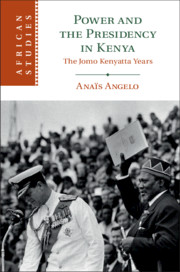Book contents
- Power and the Presidency in Kenya
- African Studies Series
- Power and the Presidency in Kenya
- Copyright page
- Dedication
- Contents
- Acknowledgments
- Introduction
- 1 Kenyatta’s Stateless Political Imagination
- 2 From Prison to Party Leader, an Ambiguous Ascension (1958–1961)
- 3 Kenyatta, Land, and Decolonization (1961–1963)
- 4 Independence and the Making of a President (1963–1964)
- 5 Kenyatta, Meru Politics, and the Last Mau Mau (1961/3–1965)
- 6 Taming Oppositions: Kenyatta’s “Secluded” Politics (1964–1966)
- 7 Ruling over a Divided Political Family (1965–1969)
- 8 “Kenyatta Simply Will Not Contemplate His Own Death” (1970–1978)
- Conclusion
- Sources
- Bibliography
- Index
- African Studies Series
5 - Kenyatta, Meru Politics, and the Last Mau Mau (1961/3–1965)
Published online by Cambridge University Press: 11 October 2019
- Power and the Presidency in Kenya
- African Studies Series
- Power and the Presidency in Kenya
- Copyright page
- Dedication
- Contents
- Acknowledgments
- Introduction
- 1 Kenyatta’s Stateless Political Imagination
- 2 From Prison to Party Leader, an Ambiguous Ascension (1958–1961)
- 3 Kenyatta, Land, and Decolonization (1961–1963)
- 4 Independence and the Making of a President (1963–1964)
- 5 Kenyatta, Meru Politics, and the Last Mau Mau (1961/3–1965)
- 6 Taming Oppositions: Kenyatta’s “Secluded” Politics (1964–1966)
- 7 Ruling over a Divided Political Family (1965–1969)
- 8 “Kenyatta Simply Will Not Contemplate His Own Death” (1970–1978)
- Conclusion
- Sources
- Bibliography
- Index
- African Studies Series
Summary
Chapter 5 investigates how the Kenyan government organized a repression against the Mau Mau fighters who refused to surrender upon independence. The chapter focuses on the Meru district, in Eastern province, where prominent Mau Mau leaders continued to be active. Meru was also the home-district of the future Minister for Lands, appointed by Kenyatta himself Jackson Angaine. A detailed analysis of Jackson Angaine’s biographical background explains why the president chose a man with an ambiguous Mau Mau past and troubled links to the traditional institutions of the district. The chapter highlights the essential connection between the government’s repression of resilient Mau Mau fighters and the shaping of the Ministry of Lands as a powerful institution to cut short subversive land claims. It explains how Kenyatta managed to pacify and control potentially subversive districts without risking his popularity. His ability to satisfy diverging expectations was at stake: those of the landless, squatters and former Mau Mau fighters, who demanded free redistribution of land, and those of the white settlers and British authorities, whose support for the government hinged on the willing buyer-willing seller principle of land buying agreed on at independence.
Keywords
- Type
- Chapter
- Information
- Power and the Presidency in KenyaThe Jomo Kenyatta Years, pp. 141 - 178Publisher: Cambridge University PressPrint publication year: 2019

